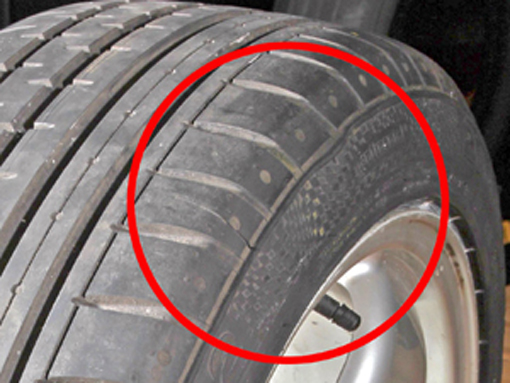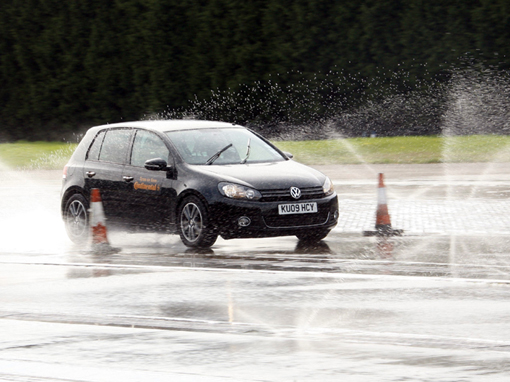This tyre could kill you
After an eye-opening day with Continental Tyres at Mira, wheelworldreviews Editor David Hooper warns that you neglect your tyres at your peril!
YOUR tyres are the only things that keep you on the road, get you round that next bend, and stop you quickly should anything happen – yet these vital items of equipment are routinely neglected and abused by the majority of car owners.
If something on your car breaks, makes a funny noise, or stops working, most of us will be straight round to the garage to get it sorted out, but just think for a moment – when was the last time you checked your tyre pressures, the depth of their tread, or inspected the sidewalls for damage?
Tyres are a science in their own right, a concoction of compounds which are combined to create the black rubber rings we put onto our cars. We get through 250,000 of them per day and as was graphically demonstrated to me, you neglect them at your peril.
I spent a fascinating day at the motor industry research and development facility at Mira, in Warwickshire, with premium tyre manufacturer Continental, and was educated, surprised and frightened in equal measure.
Continental tests 120,000 tyres every year, employ 1,000 research and development engineers in 11 locations in different climates around the world and use up to 15 different rubber compounds in one tyre, with one in three new cars in Europe being sold with Continental Tyres as original equipment.
We were shown how tyres are made, shown cross-sections of a normal tyre which has a sidewall around 4mm thick, and compared that to the cross-section of a run-flat tyre, which has a sidewall thickness of around 1cm, which explains why the far less flexible run-flat tyre causes ride-quality issues on some premium German cars on Britain’s rough roads.
We were also given a selection of worn tyres to examine to find dangerous faults. Some were worn down to the inner canvas and were easy to spot, but one tyre was particularly difficult to fault. Eventually a bulge in the sidewall was found, probably caused by hitting a kerb or a pot hole. Even a low speed impact with a kerb could prove fatal should that weak spot give way at speed and cause a blow-out.
We were also shown Continental’s latest technology, a new tyre called the Conti Seal, which has a layer of sticky stuff inside it which will seal around nails, screws or other sharp objects that may penetrate it.
Should you get a puncture, many cars now come with a can of sealant, and a pump to apply it with. If your car has something similar in its boot in place of a proper spare wheel, read the instructions before you need to use it. You don’t want to have to work it out on a hard shoulder on a Sunday night in the pouring rain. Continental’s aftermarket system, which is actually quite easy to use, costs £59.99.
The most enlightening and graphic demonstrations though, were out on the test facilities. Tyres only have tread to dispel water and keep the car in contact with the road’s surface. If we never had rain, we could all run around on slicks, like racing cars do on a dry track. But the less tread there is on a tyre, the less water it can clear.
We had three VW Golfs to drive at speed onto a wet road surface. Each car was travelling at exactly 56mph on cruise control, when after a set of cones, we were instructed to stand on the brakes and stop the car as quickly as possible.
The first car had a new set of tyres with 8mm of tread. A special device revealed that the car came to a halt in 27.9m. The second car wore a set of well used tyres with 3mm of tread. In the same test, it came to a halt in 37.5m. The third car was shod with a set of tyres at the legal limit of 1.6mm of tread. In this car, when I hit the brakes, it seemed to accelerate as it aqua-planed on the surface of the water, until it slowed enough for the tyres to find grip. For a few moments, it looked as though we were going to run out of space before the car came to a halt. It finally pulled up in an alarming 44m – several car lengths after the other two stopped.
Here’s another statistic that will make you think. Take two identical cars, one with new tyres with 8mm of tread, and the other with old tyres, worn down to the 1.6mm legal limit. They are both travelling on a wet motorway at 70mph and brake hard at the same time. When the car with the new tyres has stopped, the other car will still be doing 50mph. How scary is that – especially if the other car is behind yours with its new tyres?
Add incorrect tyre pressures and there’s more trouble waiting to happen. Another test featured two identical cars. The only difference was that the second car had its rear tyre pressures reduced by a third, from the correct 30psi, down to 20psi. Its tyres were low profile, with a narrow sidewall, and there was no visible difference, but on a slippery, wet surface… The first car negotiated a twisty course without any problems, but the car with the lower rear tyre pressures was all over the place, it’s back end sliding wildly from side to side.
It was another graphic demonstration of why you should look after, check and inspect your tyres very regularly.
It can save you money, too. Under-inflated tyres, with 20% less pressure than they should have, will increase fuel consumption by 4% and increase tyre wear. The increased wear, heat build-up and pressure on the sidewalls are responsible for 90% of tyre blow outs.
Apparently 70 per cent of cars on UK roads have at least one faulty tyre. I checked mine last weekend. Now it’s your turn. After all, add together the footprints of your four tyres (the bit in contact with the road surface) and together they will only just equal the size of a piece of A4 paper.
That is all you have to keep you and your family safe – so your tyres should definitely not be taken for granted, they should be the first thing that you check, and believe me, you should check them regularly.



OMG…. l’ve just read this article and been so moved l am going to the garage this afternoon to have my faulty (yes l already know they are faulty tyres) changed!! My front tyres keep going down to 19psi…. so l just fill them weekly…. until now. I am a changed woman!
This article is a real wake-up call for everyone who drives….. well done to the reviewer and Wheel World Reviews!